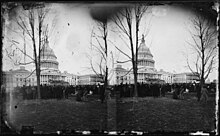47th United States Congress
| 47th United States Congress | |
|---|---|
|
46th ←
→ 48th
|
|

United States Capitol (1877)
|
|
| March 4, 1881 – March 4, 1883 | |
| Senate President |
Chester A. Arthur (R) until September 19, 1881 Vacant from September 19, 1881 |
| Senate Pres. pro tem: |
Thomas F. Bayard (D) David Davis (I) George F. Edmunds (R) |
| House Speaker: | J. Warren Keifer (R) |
| Members: | 76 Senators 293 Representatives 8 Non-voting members |
| Senate Majority: | Democratic |
| House Majority: | Republican |
| Sessions | |
|
Special: March 4, 1881 – May 20, 1881 Special: October 10, 1881 – October 29, 1881 1st: December 5, 1881 – August 8, 1882 2nd: December 4, 1882 – March 3, 1883 |
|
The Forty-seventh United States Congress was a meeting of the legislative branch of the United States federal government, consisting of the United States Senate and the United States House of Representatives. It met in Washington, D.C. from March 4, 1881 to March 4, 1883, during the administration of U.S. President James A. Garfield, and the first year of the administration of his successor, U.S. President Chester A. Arthur. The apportionment of seats in this House of Representatives was based on the Ninth Census of the United States in 1870. The House had a Republican majority; the Senate was evenly divided (The Great Senate Deadlock of 1881).
The count below identifies party affiliations at the beginning of the first session of this Congress, and includes members from vacancies and newly admitted states, when they were first seated. Changes resulting from subsequent replacements are shown below in the "Changes in membership" section.
(R)
This list is arranged by chamber, then by state. Senators are listed in order of seniority, and Representatives are listed by district.
Senators were elected by the state legislatures every two years, with one-third beginning new six-year terms with each Congress. Preceding the names in the list below are Senate class numbers, which indicate the cycle of their election.
Members' names are preceded by their district numbers.
(8 Democrats)
(4 Democrats)
(2-2 split)
(1 Republican)
(3-1 Republican)
(1 Democrat)
(1-1 split)
(9 Democrats)
(13-6 Republican)
(8-5 Republican)
(9 Republicans)
(3 Republicans)
(10-1 Democratic)
...
Wikipedia
